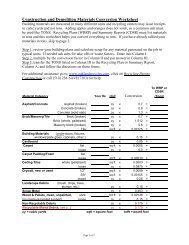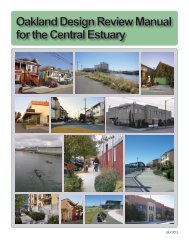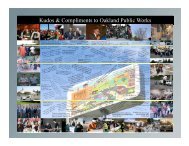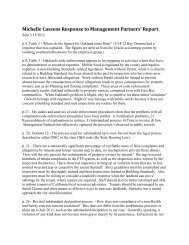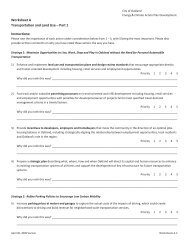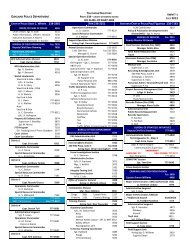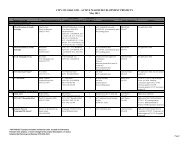Intelligent Transportation Systems - City of Oakland
Intelligent Transportation Systems - City of Oakland
Intelligent Transportation Systems - City of Oakland
You also want an ePaper? Increase the reach of your titles
YUMPU automatically turns print PDFs into web optimized ePapers that Google loves.
4.3.2 Kiosks<br />
Kiosks are becoming an important traveler information communication device and have<br />
been adopted by many transportation agencies. Kiosks can allow travelers to access<br />
current data on road and weather conditions, directions to destinations specified, and<br />
current news regarding local events.<br />
An automated kiosk is a stand-alone unit most commonly containing a computer terminal<br />
and some form <strong>of</strong> user interface (e.g., keyboard, touch screen). The Port <strong>of</strong> <strong>Oakland</strong><br />
has expressed a desire to install a kiosk in one <strong>of</strong> their Airport terminals. Kiosks also<br />
could be installed at major transit centers near the Coliseum. Although a kiosk could be<br />
installed in a completely stand-alone facility it is unlikely that a traveler would stop just to<br />
use the kiosk, for both convenience and safety reasons.<br />
A kiosk consists <strong>of</strong> four primary components: interactive presentation s<strong>of</strong>tware; a<br />
personal computer; user interfaces such as the display, keyboard, touch screen and<br />
telephone; and the physical enclosure. Because the public has physical access to the<br />
kiosk and is able to interact with a remote system, topics not always associated with<br />
information systems must be addressed. Some <strong>of</strong> these topics are physical security,<br />
data security, identification <strong>of</strong> the user, use by untrained operators, and compliance with<br />
the Americans with Disabilities Act.<br />
These last two topics present opportunities for state-<strong>of</strong>-the-art technology to aid the user<br />
community. Hearing-impaired persons can use standard touch screens. For the visually<br />
impaired, a telephone can be provided that uses audio prompts to activate kiosk<br />
commands via a Braille-like telephone keypad. Additional Braille-like menus can be<br />
mounted on the kiosk surface to aid in the communication. All users, whether physically<br />
impaired or not, desire a positive feedback to know that they have successfully engaged<br />
an interactive button or other input device; therefore, the kiosk must react with positive<br />
visual and audio responses to all input by the user. Moreover, effective use <strong>of</strong> graphics<br />
and sound provides an engaging presentation that makes the kiosk experience not only<br />
informative but also entertaining.<br />
Given the potentially high costs <strong>of</strong> implementing and maintaining kiosks, careful<br />
consideration should go into their planning. It is anticipated that optimal benefits <strong>of</strong><br />
kiosks will be derived by those travelers with limited accessibility to traveler information<br />
(e.g., travelers without Internet access).<br />
Kiosk Recommendations – It is recommended that traveler information kiosks be<br />
considered for medium- or long-term deployment in the <strong>City</strong> <strong>of</strong> <strong>Oakland</strong>. Unfortunately,<br />
MTC has discontinued their TravInfo® kiosk initiative so there are currently no<br />
opportunities to share in regional efforts to develop kiosks. However, the <strong>City</strong> should still<br />
consider developing kiosks that would be based on a <strong>City</strong> traveler information web site<br />
(see next section). The kiosks could be linked to the web site and provide the same<br />
information including traffic maps, incident updates, traffic images and transit<br />
information. The kiosks could also have a link to other regional traveler information<br />
systems such as East Bay SMART Corridors and 511/TravInfo®. Kiosks should be<br />
deployed at locations where many people are likely to pass them while traveling such as<br />
<strong>Oakland</strong> Airport terminals, major transit hubs and the Downtown Convention Center.<br />
<strong>City</strong> <strong>of</strong> <strong>Oakland</strong> ITS Strategic Plan<br />
48 September, 2003







